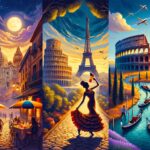Starting in Spain and ending in Italy, this blog post will guide you on how to travel seamlessly through France, offering tips and insights for an unforgettable journey across these three marvelous European countries.
Traveling from Spain to France to Italy is an incredible adventure that allows you to experience the rich cultures, stunning landscapes, and iconic landmarks of three distinct nations. Whether you’re a seasoned traveler or embarking on your first multi-country trip, this article will provide the necessary information and inspiration to make your journey a memorable one.
Before diving into the details of transportation options, border crossings, and must-visit destinations, it’s important to properly prepare for your trip. Researching the best time to travel is crucial, considering factors such as weather conditions, peak tourist seasons, and local festivals or events.
Gathering all necessary travel documents like passports and visas is essential to ensure smooth border crossings. Additionally, planning your budget and setting aside funds for transportation, accommodation, activities, and food will help you make the most of your journey without breaking the bank.
Throughout this article, we’ll explore different transportation options available for traveling between Spain, France, and Italy. From flights that offer convenience and speed to trains that showcase breathtaking scenery along the way, each mode of transport has its pros and cons – which we’ll delve into further. We’ll also highlight suggested starting points in Spain such as Barcelona or Madrid before crossing into France.
As we venture through France’s key cities accessible from the Spanish border like Perpignan or Montpellier, there are countless cultural landmarks, gastronomic delights, and scenic routes awaiting discovery. Finally crossing into Italy – a gateway to ancient history and artistic masterpieces – we’ll suggest popular cities like Rome or Florence while providing tips for getting around within Italy.
Embarking on a multi-country journey from Spain to France to Italy unlocks a treasure trove of diverse experiences just waiting to be explored. So pack your bags and get ready for an adventure of a lifetime as we guide you through these three marvelous European countries.
Preparing for the Trip
Before embarking on your journey from Spain to France to Italy, it is important to take some essential steps in preparing for your trip. By following these guidelines, you can ensure a smooth and hassle-free travel experience.
Researching and Choosing the Best Time to Travel:
One of the first things you should do when planning your trip is to research and choose the best time to travel. Consider factors such as weather conditions, peak tourist seasons, and any significant events or holidays that may affect your itinerary. Each country has its own unique charm during different times of the year, so it’s worth taking the time to find out which season aligns with your preferences.
Gathering All Necessary Travel Documents:
Before setting off, gather all necessary travel documents such as passports, visas, or any other identification required by each country. Ensure that your passport is valid for at least six months beyond your planned departure date. It is also advisable to make copies of all these documents and store them separately in case of loss or theft.
Planning Your Budget:
To avoid any financial surprises along the way, it is crucial to plan your budget ahead of time. Consider all aspects of your trip including transportation costs (flights, trains, buses), accommodation expenses, activities and attractions fees, and daily food expenses. Researching approximate costs in each country will help you set aside adequate funds and ensure a stress-free journey.
Setting aside extra money for unforeseen circumstances is always wise as emergencies can happen even while on vacation. It’s also important to consider currency exchange rates in each country and factor them into your budget calculations.
By taking these necessary steps during the preparation phase of your trip from Spain to France to Italy, you’ll be well-equipped for an unforgettable journey across these marvelous European countries.
Choosing Transportation Options
When embarking on a journey from Spain to France to Italy, one of the most important considerations is choosing the right transportation options. Each mode of transportation comes with its own advantages and disadvantages, so it’s crucial to weigh them against your preferences, budget, and travel goals.
Flights provide a fast and efficient way to travel between countries. There are various airlines that offer direct flights between major cities in Spain, France, and Italy. This option is particularly appealing if you have limited time or want to cover long distances quickly. However, it’s important to note that flying may require extra time for airport check-ins and security procedures.
Trains are an iconic way to explore Europe, offering both convenience and scenic views along the way. The train network in Europe is extensive and well-connected, making it easy to travel between cities in Spain, France, and Italy. High-speed trains like the TGV or AVE can whisk you away between countries in no time. Additionally, taking the train allows you to relax, enjoy the scenery, and avoid traffic congestion or parking hassles.
Buses are a budget-friendly alternative for traveling within and between these countries. Many companies provide long-distance bus services that connect major cities across Spain, France, and Italy. While buses may take longer than other forms of transportation due to frequent stops along the way, they offer flexibility and a chance to see more of the countryside. Moreover, bus tickets usually cost less than train or plane tickets.
Finally, renting a car provides flexibility and independence for your cross-country journey. With a car rental service at your disposal, you can easily explore off-the-beaten-path destinations or make spontaneous stops along the way. However convenient it may be though,some factors need consideration such as driving laws in each country – including tolls or permits – parking availability at each destination,and cost considerations regarding fuel consumption.
Ultimately,the choice of transportation depends on your priorities: Do you value speed, comfort, cost-efficiency, flexibility or the experience of seeing the landscape from a certain perspective? By carefully considering your options and making an informed choice,you can ensure that your journey from Spain to France to Italy is just as enjoyable as the destinations themselves.
Starting in Spain
If you’ve chosen to start your journey from Spain, you have two fantastic cities to begin your adventure: Barcelona and Madrid.
- Barcelona: Known for its stunning architecture, vibrant culture, and vibrant nightlife, Barcelona is a popular starting point for many travelers. Make sure to visit the iconic Sagrada Familia, Parc Güell, and the Gothic Quarter. Explore the bustling streets of Las Ramblas and indulge in tasty tapas at Mercat de Sant Josep de la Boqueria.
- Madrid: As the capital city of Spain, Madrid offers a mix of tradition and modernity. Visit world-renowned museums like the Prado Museum and Thyssen-Bornemisza Museum or take a leisurely stroll through Retiro Park. Don’t miss out on tasting traditional Spanish cuisine in the lively neighborhood of La Latina or catching a flamenco show in the historic district of Lavapiés.
Before moving on to France, take the opportunity to explore more of what Spain has to offer. Travel southward to Andalusia and witness the beauty of Granada’s Alhambra palace or Seville’s striking cathedral. Alternatively, head north towards San Sebastián for its picturesque beaches and renowned local cuisine. Whichever route you choose, Spain will leave you captivated with its rich history and diverse landscapes.
Once you’re ready to embark on the next leg of your journey, there are various transportation options available from Spain to France. Consider taking a scenic train ride from Barcelona or Madrid to cross over into France or hop on a short flight if time is limited. The choice ultimately depends on your preferences for convenience, cost, and scenic views along the way.
Crossing the Border into France
When traveling from Spain to France, there are several options for crossing the border. The most common modes of transportation include flights, trains, buses, and driving. It is important to consider your preferred method of travel based on factors such as cost, time, and convenience.
If you choose to fly from Spain to France, there are numerous direct flights available between major cities like Barcelona and Paris. This option provides a quick and efficient way to cross the border, especially if you have limited time. However, keep in mind that air travel may be more expensive compared to other modes of transportation.
For those who prefer a more scenic journey with flexibility in their itinerary, taking a train is an excellent choice. The train network between Spain and France is well-developed and offers convenient connections between major cities. Companies such as Renfe-SNCF provide high-speed trains that can take you from Barcelona or Madrid to destinations like Paris or Marseille in just a few hours.
If you’re looking for a budget-friendly option and want more control over your schedule, taking a bus can be a great alternative. There are several bus companies that operate routes between Spain and France, offering affordable fares and flexible departure times. Keep in mind that bus travel may take longer compared to other options due to potential traffic congestion at border crossings.
Finally, driving across the border gives you the freedom to explore at your own pace. Keep in mind that crossing by car requires thorough planning regarding documents such as international driver’s licenses and insurance coverage. Additionally, familiarize yourself with any specific road regulations or toll fees applicable in both countries.
When crossing the Spain-France border, ensure that you have valid passports and any necessary visas or travel documents. Familiarize yourself with any customs requirements or restrictions to avoid potential delays or issues at the border. It is always recommended to check the latest information from official authorities before your trip.
Once you’ve successfully crossed into France, there are several key cities that are easily accessible from the Spanish border. Perpignan, located just north of the border, offers a mix of Catalan and French culture. Its charming old town, historic sites, and vibrant food scene make it a worthwhile stop for travelers. Another option is Montpellier, known for its beautiful architecture, lively atmosphere, and thriving arts scene.
Exploring these cities allows you to ease into French culture and begin your journey through this magnificent country. By starting in Spain and crossing into France, you’ll embark on an unforgettable adventure through diverse landscapes, culinary delights, and mesmerizing sights as you make your way towards Italy.
Discovering France
When traveling from Spain to Italy, exploring France is an essential part of the journey. France is renowned for its rich history, stunning landscapes, and world-class cuisine. In this section, we will provide suggestions for must-visit cities and attractions in France, offer tips for transportation within the country, and highlight unique experiences along the way.
Must-Visit Cities and Attractions
France boasts a myriad of iconic cities that should not be missed when traveling through the country. Paris, the capital city, offers a wealth of cultural landmarks such as the Eiffel Tower, Louvre Museum, and Notre-Dame Cathedral. The charming city of Nice on the French Riviera is known for its beautiful beaches and vibrant atmosphere.
Lyon is a gastronomic paradise with its renowned Michelin-starred restaurants and traditional bouchons. Other notable destinations include Bordeaux with its world-famous wine region, Toulouse known as “La Ville Rose” for its distinctive pink brick architecture, and Strasbourg with its stunning blend of French and German influences.
Tips for Transportation
Getting around France is a breeze due to its extensive transportation network. Train connections are reliable and efficient, making it the preferred mode of travel for many visitors. The high-speed train service (TGV) connects major cities across the country. Regional flights are also available for longer distances or reaching more remote areas. Additionally, local buses provide convenient options to explore smaller towns or countryside regions.
Unique Experiences
While visiting France, take advantage of unique experiences that showcase the country’s diverse culture and breathtaking landscapes. Embark on a wine tour in Bordeaux or Burgundy to indulge in some of the finest wines produced in these regions. Explore the beautiful coastline of Normandy with its striking cliffs overlooking picturesque villages and sandy beaches.
Discover medieval architecture in Carcassonne or wander through the lavender fields of Provence. And let’s not forget about the breathtaking beauty of the French Alps, offering opportunities for hiking, skiing, and enjoying scenic mountain vistas.
France truly has something for everyone, whether you’re a history enthusiast, a gastronomic adventurer, or a nature lover. By immersing yourself in the unique experiences that each city and region has to offer, your journey through France will undoubtedly be an unforgettable part of your overall trip.
Crossing the Border into Italy
After exploring the wonders of France, it’s time to cross the border into Italy. As you make your way from the enchanting cities of France to the vibrant destinations in Italy, there are several options available for a seamless transition.
There are three main ways to cross the France-Italy border: by air, by train, or by road. If you’re looking for speed and convenience, flying is the quickest option. Many major Italian cities have international airports with direct flights from various locations in France. Milan and Turin are popular entry points in Italy and offer great flight connections.
If you prefer a more scenic journey and want to take in the stunning landscapes of both countries along the way, traveling by train is an excellent choice. There are multiple train routes that connect France to Italy, providing not only a convenient mode of transportation but also an opportunity to admire the picturesque countryside. The high-speed trains operated by TGV and Italo can whisk you from Paris or Nice directly into major Italian cities like Rome or Florence.
For those who enjoy the freedom of a road trip and want to explore smaller towns or countryside areas, driving across the border is an appealing option. From southern France, there are several highway crossings that link to Italy, such as Ventimiglia or Menton. Just be mindful of any tolls or road regulations specific to each country.
Before embarking on your journey into Italy, it’s important to familiarize yourself with any immigration procedures or customs regulations that may apply when crossing the border. Ensure that you have all necessary travel documents handy, including your passport and any required visas. It’s also advisable to check if there are any specific COVID-19 travel restrictions or guidelines in place at the time of your trip.
Once you’ve successfully crossed into Italy, cities like Milan and Turin await with their rich history and cultural offerings. Milan is renowned for its fashion scene and iconic landmarks such as the Duomo di Milano, while Turin boasts stunning architecture and culinary delights. These cities serve as excellent starting points for further exploration of the diverse regions in Italy.
Whether you choose to fly, take a train, or drive across the border, your journey from France to Italy will undoubtedly be filled with anticipation and excitement. As you enter Italy, get ready to immerse yourself in a country known for its art, history, and delectable cuisine. The next section will delve into the various Italian cities and destinations that should not be missed during your incredible multi-country adventure.
| Transportation Mode | Advantages | Considerations |
|---|---|---|
| Flying | – Speed and convenience
| – May incur additional costs for luggage
|
| Train | – Scenic journey with picturesque landscapes along the way
| – Depending on the route, may require transfers or multiple train changes
|
| Road trip (Driving) | – Freedom to explore smaller towns and countryside areas
| – Need for international driving permit if you don’t have a European Union (EU) driving license
|
Exploring Italy
Italy, known for its rich history, vibrant culture, and stunning landscapes, offers numerous cities and attractions to explore. Whether you’re a history buff, art enthusiast, food lover, or nature adventurer, Italy has something for everyone. In this section, we will introduce some popular Italian cities and tourist destinations and provide travel tips to help you make the most of your visit.
One of the most iconic cities in Italy is Rome, the capital city and a treasure trove of ancient ruins and historical landmarks. From the Colosseum to the Roman Forum to the Vatican City with St. Peter’s Basilica and the Sistine Chapel, Rome offers a glimpse into centuries of civilization. Don’t forget to indulge in some authentic Roman cuisine like pasta carbonara or gelato.
Another must-visit destination in Italy is Florence, renowned for its Renaissance architecture and world-class art collections. Visit the famous Duomo Cathedral with its Brunelleschi dome or explore the Uffizi Gallery housing works by Botticelli, Michelangelo, and Leonardo da Vinci. Take a stroll along the Ponte Vecchio bridge or savor delicious Tuscan dishes like bistecca alla Fiorentina or ribollita.
Venice is a unique city built on water that captivates visitors with its romantic canals and charming atmosphere. Explore St. Mark’s Square with its stunning basilica and bell tower before taking a gondola ride through the narrow canals. Indulge in Venetian cuisine like risotto al nero di seppia or sarde in saor while immersing yourself in this magical city’s beauty.
If you have more time on your itinerary, consider visiting the Amalfi Coast. With its picturesque cliffside villages overlooking crystal-clear waters of the Tyrrhenian Sea, it’s no wonder this coastline attracts tourists from around the world. Visit Positano for its colorful houses cascading down the hills or Ravello for its stunning gardens and breathtaking views. Be sure to try local lemon-infused dishes like spaghetti al limone or enjoy a boat tour along the coast.
Italy’s rich cultural heritage, world-famous cuisine, and spectacular landscapes make it a top destination for travelers. Whether you choose to explore the big cities or venture off the beaten path to discover hidden gems, Italy promises unforgettable experiences at every turn. Plan your itinerary wisely, immerse yourself in the local culture, and get ready to create lasting memories in this captivating country.
Final Thoughts
Traveling from Spain to France and then to Italy can be an incredible adventure, offering a rich tapestry of cultures, landscapes, and experiences. By embarking on this multi-country journey, you have the opportunity to immerse yourself in the beauty of three marvelous European countries.
Spanning from the vibrant streets of Barcelona or Madrid in Spain, to the romantic backdrop of Paris or the scenic French Riviera in France, and finally arriving at the historical wonders of Rome or the picturesque canals of Venice in Italy – each destination promises unforgettable memories.
One advantage of traveling through Spain, France, and Italy in one trip is the diversity you will encounter along the way. From tapas and flamenco in Spain to croissants and art museums in France, and pasta and ancient ruins in Italy – your taste buds, senses, and cultural appreciation will be constantly stimulated.
Moreover, these three countries offer a range of landscapes that will take your breath away – from the stunning beaches along Spain’s coastlines to the impressive mountains in the French Alps or Italian Dolomites.
To optimize your journey through these three countries, it is important to plan ahead and consider any specific requirements or restrictions for each destination. Researching the best time to travel can help you avoid peak tourist seasons while still enjoying pleasant weather conditions.
Gathering all necessary travel documents such as passports and visas ahead of time ensures a smooth transition between borders. Additionally, setting aside funds for transportation options like flights or trains, accommodation choices that suit your budget, immersive activities unique to each country, as well as local cuisine experiences will ensure a memorable trip.
Now that you have learned about how to prepare for this epic journey across Spain, France, and Italy – with invaluable tips on transportation options and border crossings – it’s time for you to embark on this adventure yourself. Whether you’re traveling for leisure or seeking cultural enrichment through history and art; indulging in culinary delights or embracing the diverse landscapes and vibrant cities – this multi-country trip promises to provide a once-in-a-lifetime experience.
Plan your itinerary, pack your bags, and get ready for a journey of a lifetime through the wonders of Spain, France, and Italy.
Sample Itinerary
For those eager to embark on a journey through Spain, France, and Italy, here is a sample itinerary that highlights the best of each country while maximizing your time and experiences. Of course, this itinerary can be customized based on personal preferences and available time.
Day 1-3: Barcelona, Spain
Start your trip in vibrant Barcelona, where you can explore the famous Gothic Quarter, marvel at the stunning architecture of Antoni Gaudí’s masterpieces like Sagrada Familia and Park Güell, and savor delicious tapas in the charming neighborhoods. Don’t forget to visit the beautiful beaches for some relaxation.
Day 4-6: Paris, France
Take a flight or a high-speed train to the romantic city of Paris. Spend your days wandering through picturesque streets, visiting iconic landmarks like the Eiffel Tower and Louvre Museum, indulging in French cuisine at quaint cafes, and taking leisurely boat rides along the Seine River.
Day 7-9: Florence, Italy
Fly from Paris to Florence and immerse yourself in Renaissance art and architecture. Explore historic sites such as the Duomo Cathedral and Uffizi Gallery, stroll across Ponte Vecchio bridge, and enjoy breathtaking views from Piazzale Michelangelo. Sample authentic Italian gelato as you soak up the artistic atmosphere.
Day 10-12: Rome, Italy
Relish in the history and grandeur of Rome as you visit attractions like the Colosseum, Roman Forum, Vatican City (including St. Peter’s Basilica and Sistine Chapel), and Trevi Fountain. Indulge in delectable Italian cuisine at traditional trattorias while wandering through charming cobblestone streets.
Day 13-15: Amalfi Coast/Positano/Capri.
End your journey with a taste of paradise along Italy’s stunning Amalfi Coast. Spend two days soaking up the sun in Positano, with its picturesque colorful houses and captivating views of the sea. Take a day trip to the enchanting island of Capri and explore its charming town, natural grottoes, and breathtaking viewpoints.
This sample itinerary showcases some of the most popular cities in Spain, France, and Italy while allowing enough time to truly appreciate each destination. However, remember to adjust it according to your own interests and available time.
Whether you are captivated by the rich history of Rome or enchanted by the romantic streets of Paris, a journey through Spain, France, and Italy promises an unforgettable adventure. So pack your bags, plan your own multi-country itinerary, and prepare to lose yourself in the wonders of these marvelous European countries. Bon voyage.
Frequently Asked Questions
What is the best way to travel from Spain to Italy?
The best way to travel from Spain to Italy largely depends on personal preferences and time constraints. One option is to fly, as there are numerous direct flights connecting major cities in both countries. This is generally the quickest and most convenient method, especially for those with limited time.
Another option is to take a train, which offers a more scenic journey and allows travelers to experience different landscapes along the way. However, this can be a longer and potentially more expensive option. Finally, there are also ferry services available that allow you to travel between Spain and Italy by sea, providing a unique and leisurely travel experience for those who enjoy being on the water.
Can I go from Spain to France by train?
Yes, it is possible to go from Spain to France by train. There are several high-speed trains, such as the Renfe-SNCF TGV service, that connect major cities in both countries.
For example, you can catch a train from Barcelona or Madrid in Spain and arrive in Paris or other French cities within just a few hours. Train travel offers an efficient and comfortable way to cross the border between these two neighboring countries without the need for air travel or lengthy road trips.
How much does it cost to travel from Spain to Italy?
The cost of traveling from Spain to Italy depends on various factors including the mode of transportation chosen, time of booking, class of service, and specific destination within Italy. Flying tends to be relatively affordable if booked in advance or during promotional periods offered by airlines. However, prices can vary greatly depending on factors like luggage allowance and flight availability.
Taking a train may also require booking tickets ahead of time for better fares, but again prices may fluctuate based on demand and class of seating chosen. Similarly, ferry prices will depend on factors such as cabin type (private or shared) and duration of the journey since some ferries offer overnight options. It’s advisable to compare prices across different transport options while keeping flexibility in dates as this can often lead to more cost-effective travel within Spain and Italy.

I’m a passionate traveler, writer, and Italophile. My fascination with Italy’s history, art, and culture has led me on countless adventures across the Italian landscape. Through “I Live Italy,” I share my love for this extraordinary country and aims to inspire others to explore its boundless beauty.





